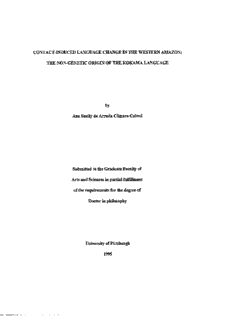
THE NON-GENETIC ORIGIN OF THE KOKAMA LANGUAGE by Ana Suelly de Arruda Cim PDF
Preview THE NON-GENETIC ORIGIN OF THE KOKAMA LANGUAGE by Ana Suelly de Arruda Cim
CONTACT-INDUCEDLANGUAGECHANGEINTHEWESTERNAMAZON: THENON-GENETIC ORIGINOFTHEKOKAMALANGUAGE by AnaSuellydeArrudaCimaraCabral SubmittedtotheGraduateFacultyof ArtsandSciencesin partialfulfillment oftherequirementsforthedegreeof Doctorinphilosophy UruwenityofPitisbwgh 1995 UNIVERSITYOFPITISBURGH FACUU"YOFARTSAND SCIENCES Thisdisse:tltionwaspresented by Ana Suellv Arruda Camara Cabral Itwasdefendedon December 14, 1995 andapprovedby ....:L.~.... -~.-s,k<"7'- Susan Berk-Seligson / ~/l-. -~8 ~ CONTACT·INDUCEDLANGAGECHANGEINTHEWESTERNAMAZON: THENON-GENETICORIGINOFTHEKOKAMALANGUAGE ". Cabral,AnaSuellyA.Co,Ph.D. UniversityofPittsburgh ABSTRAcr Thisdissertationdiscussesthenon-geneticoriginoftheKokamalOmawalanguage.afactfiIst: observedbyRodrigues (1984-1985). KokarnaisoneoftbenativeSouthAmericanIndianlanguagesspoken atpresentinlowlandPeruandonitswaytoextinction.UntilnowKokamahasbeenclassifiedasalanguage belongingtotheTupi~uaranilinguisticfamilyonthebasisofsmalllistsofbasicvocabulary(Loukotka. 1968;LenUe.1971.~goth~). BasedonThomason'sandKanfinan's(1988)analyticalmodeloncontact-inducedchange.I present evidencetoprovethaIKokamacannotevenbeclassifiedgeneticallybecauseitslinguisticsubsystemsdonotfind correlatesinasinglelanguageorlinguisticfamilysomce.'IbisisrevealedthroughafullcomparisonofKokama. andTupinambawithrespecttolexiconandgrammar.Theresultofthecomparisonconstitutesproofthat.except forlexicalsimilaritiesandanumberofsoundconespondences.KokamadiffersgreatlyfromtheTupinamba languageinitsphonology.morphologyandsyntaX.thoughthelatteristhesourceofasigrrific:mtportionofthe vocabularyoftheformer. AreconstructionofthesocialhistoryoftheKokamalOmawapeopleshowsthepossiblesocialcontext fromwhichKokamastarteddevelopingtowardsanindependentlinguisticsystem:themissionaryvillagescreated bytheJesuitsintheProvinciadeMaynas. There.speakersofdifferentIndianlanguagesneededacommonmode ofcommuniCaIion.TheKokamalOmawalanguagewastheofficiallanguageinthesemissionaryvillagesandthe noo-Tupi~uaranispeakershadtolearnitrapidly,inthisprocessfailingtolearntheTupf-Guaranilanguageasa iii whole.TheoriginalspeakersoftheTupinambalanguageadoptedthenewversionoftheirlanguage. wtl1chernetobecalledtheKokama. oralternativelyOmawa.language. Thisdissertationintendstocontributetothetheoryoflanguagesincontaet.andtohistorical comparativeresearchonSouthAmericanIndianlanguagesindiscussingtheoriginofanextremecase ofuuerfercncethroughlanguageshift. iv ACKNOWLEDGMENTS Thisdissertationhasdependedontheeffortsofmanypeopleforitsdevelopment. Ratherthanasa personalaccomplishment,I would!i1(etothinkofitastheresultofa collectiveeffortto \\mchmanypeoplecontributedwiththeircontinuousmoralsupport andacademicinput. MysincerethankstotheKokamapeoplefrom Sapota!,Sacambu. Orique, BenjaminConstant.Tabatinga. Leticia.andNautainBrazil.ColumbiaandPeru.who kindlycollaboratedwithmylinguisticresearchontheKokamalanguage. lowespecial thankstomyfriends andconsultantsAntonio Samias,MariaSamias,AngelinaSamias. ManuelKurike,AntonioGon9alvesPinto,ManuelPintoandBenjaminSamias. ToTerrenceKaufman.AryonDall'IgnaRodriguesandSusanBerk-Seligsonlowe a majordebt. AryonDall'IgnaRodrigues.myBrazilianprofessor,introducedmeto descriptive andhistoricallinguistics,and,mostimportantly,tothefascinatingrealmofBrazilian indigenouslanguages.Heaccompaniedmyworkthroughoutall theseyearsandsupported myacademicdevelopmentIIptothe lastpageofmydissertation. I amprofoundlyindebtedtoSusanBerk-Seligsonforbeing mydissertation adviserintheDepartmentofHispanlc LanguagesandLiteratures.Ihavegreatlybenefited fromhersuggestionsandcriticismsofmanyofthemattersdiscussedinthisdissertation. SpecialrecognitionisalsoduetoBruceStiehm,BobChamberlainandHerchel Frey. Together\\1thSusanBerk-Seligson.theytaughtmeSpanishlinguisticsand v supportedmyprojectontheKokamalanguagewithinthe DepartmentofHispanic LanguagesandLiteratures. I wouldliketoexpressmydeep gratitudetoTerrenceKaufinan andSarahGrey Thomason. Ihadtheprivilegeofbeingtheirstudentfrom 1989to 1992 inthe DepartmentofGeneralLinguisticsattheUniversityofPittsburgh. Thesetwoscholars taughtmetodo linguisticresearchinthefields ofd~ptiveandhistoricallinguistics. MostofwhatIdiscussinthisdissertationowesitstheoreticalandmethodological foundationstothem. TerrenceKaufmannotonly showedmetheroutebutalsopatiently accompanied meinnavigatingthisdissertationtosafeharbor.Thisdissertationwouldnothavebeen possiblewithouthisadviceandhisinvaluableguidance. Iamthankfulto CherylJensenandAllenJensenfortheircommentsand suggestionsonthesecondchapterofthisdissertation. Asa nativespeakerofBrazilianPortugueseandasanadultlearnerofEnglish,I couldnothavewrittenthisdissertationinEnglishwithoutthefundamental helpof TerenceKal1finan SusanBerk-Seligso~BobChamberlainandBruceStiehm. Iwouldliketoexpressmygratitudeto myBrazilianprofessorsLuciaMariaLobato andStellaMa.."isBortoniforstimulatingmetopursuemyPh.D. studies. Thanks goto myfriend ConnieTomkoforherconstantmoralandlogistichelp duringmystayintheDepartmentofSpanishLanguageandLiterature. Mysincerethanks also goto myfellowstudentsElenaRUZickova., FelixCatlin.,AndreaYanuzzi. Griselda Zuffi. RobertAllenandto myBrazilianfriends AndreaDonovan.EvaBueno.lone vi VasconcelosandMonicaPeixotofortheircontinuousencouragementandfriendship. Finally, letmeexpressmyspecialgratitudeto myparentsGeonardoandTerezinha Cabralfortheirconstantencouragementandlogisticsupportofmystudies.Thanks,too, to mysons,RudaandNicolas,whoweremycompanionsinPittsburghforoversixyears, allowingmetostudyandmakingmethinkthattheywerethesweetreasonfortheefforts I spentonmydissertation. MyPh.D.studiesweresupportedbya fellowship fromtheBrazilianNational CouncilforScientificandTechnologicalDevelopment(ConselhoNacionalde DesenvolvimentoCientificoeTecnol6gico,CNPq). FieldworkontheKokamaLanguage wassupportedbygrantsfromtheCNPqandbyfinancial aidfromtheMinistryofCulture ofBraziI. lowespecialthanksto CristinaReis,oftheCNPq,who providedmewith constantlogisticsupport.IntheMinistryofCulture,IthankGlaucoCampelo,JoseSilva Quin~VirginiaGuedesandElizabethScares. vii TABLEOFCONTENTS ABBREVIATIONS xii CHAPTERI 1. INTRODUCTION 1 1.1 BriefsurveyofthedocumentationoftheKokama language: Descriptiveandcomparativestudies 12 1.2 Languagecontact,linguistic interferenceandgenetic linguistics. Historicalbackground .,'" 1.2.1 General remarks 1.2.2 Thetreatmentofborrowing _:1 1_._.,.:'1" 24 Pidginsandcreolesversusgeneticlinguistics 34 1.2.4 Conclusion 40 1.3 Thomason& Kaufinan'stheoreticalmodel forcontaet inducedlanguagechange.A Summary 43 1.4 Conclusion 50 CHAPTERII 2. TUPINAi\fBA.AND KOKAMAPHONOLOGYAND COMPARA~PHONOLOGY 2.1 Introduction 51 2.2 TupinambaandKokamasoundcorrespondence,phonemes 58 andallophonic rules .,'" _.:1 Listofphonosemanticallyequivalentlexemes 61 2.3.1 SoundcorrespondencesbetweenTupinambaandKokama forms 74 2.3.2 Phonologicalrules (morpho-phonemics) 103 3.2.4 Conclusion 114 CHAPTERill 3. MORPHOLOGY 3.1 Introduction. 116 3.2 MorphologicalcharacteristicsofTupinambaversus Kokama Preliminaryremarks 118 :'"1.:'1" Inflectionalmorphology 119 3.3.1 Tupinambainflectionalclasses 120 :~1".':1..,_ Nominalinflection 124 3.3.2.1 Substantives 124 3.2.2.2 Numerals 125 3.3.2.3 Demonstratives 127 3.3..2,.4 Attributivecase 129 :'"1.'":1._.' Punctual locative 129 3.3.2.6 Diffuselocative 130 viii 3.3.2.7 Partitivelocative 130 3.3.2.8 Pronominalmorphologicaldative 131 3.3.2.9 Relational nouns 1"" ~~ 3.3.2.10 Verbalinflection 134 3.3.2.11 Personmarker 1~~"~- 3.3.2.12 Mood 137 3.3.2.13 Reflexiveandreciprocal 142 3.3.2.14 Negation 143 3.4 Derivational morphology 144 3.4.1 Causatives 145 3.4.2 Nominalizerofobject 146 3.4.3 Intensive 147 3.4.4 Attenuative 148 3.4.5 Negative 148 3.4.6 Nounoforigin 149 3.4.7 Nominalizersofverbalstems 115 3.4.8 Nominalizersofp~ 152 3.5 Compounding 153 3...5-..1, Determinative 153 ~.~.- Attributive 153 3.5.3 Objective 154 3.5.4 Mixedcompounding 155 3.5.5 Kokamacompounding 155 3.6 Reduplication 157 3.6.1 Monosyllabicreduplication 157 3.6.2 Disyllabicreduplication 158 3.7 Incorporation 159 3.8 Conclusion 161 CHAPTERIV 4. SINTAX 4.1 Introduction 163 4.2 TupinambaandKokamaclausetypes 167 4.2.1 TheorderofelementsinTupinambaandKokama 169 independentclauses 4.3 ThesyntaxofTupinambaandKokamanounphJ.-ases 172 4.3.1 Verbphrase 172 4.3.2 ThesyntaxofTupinambaand Kokamanounphrases 185 4.3.3 Nominaladjectivewordorder 186 4.3.4 Genitiveconstructions 188 ix 4.3.5 Numeral-nominalwordorder 189 4.3.6 Demonstrative-nominalwordorder 190 4.3.7 TupinambaandKokamarelationalphrases 190 4.4 Subordinateclauses 191 4.4.1 Adverbialclauses 194 4.42 Frontingofadverbial 198 4.5 Negation 200 4.6 Questions 209 4.6.1 YeslNoquestions 209 4.6.2 Informationquestions 210 4.6.3 Rhetoricalquestions 212 4.6.4 Answerto questions 214 4.7 Conclusion 218 CHAPTERV 5. THEKOKA..1v1APEOPLE 5.1 Introduction "'23 52 Tupi-Guaranigeographicaldistributionandmigrations withemphasisontheremote locationofKokamalOmawa groups 228 5.3 A profileoftheKokamapeople: socialorganization. economy.materialculture 239 5.4 SomeaspectsofthesocialhistoryoftheKokamalOm'awas 242 5.5 Conclusion 253 CHAPTERVI 6. THENON-TUPIA.NFEATURES OFKOKAMA 6.1 Introduction 260 62 Vocabulary 261 6.3 Phonology 275 6.4 Morphology 279 6.5 Syntax 280 6.6 Othernon-Tupianfeatures 284 6.7 Conclusion 291 CHAPTER VII 7. CONCLUSION 299 APPENDIX A: Kokamasketch 311 APPENDIX B: KokamalOmawatexts 373 APPENDIX C: Maps 398 LISTOFREFERENCES 401 x
Description: